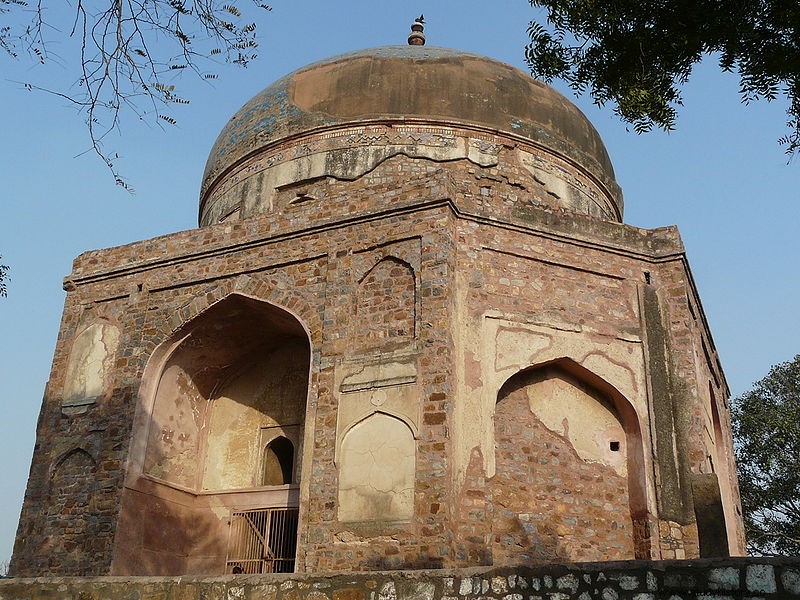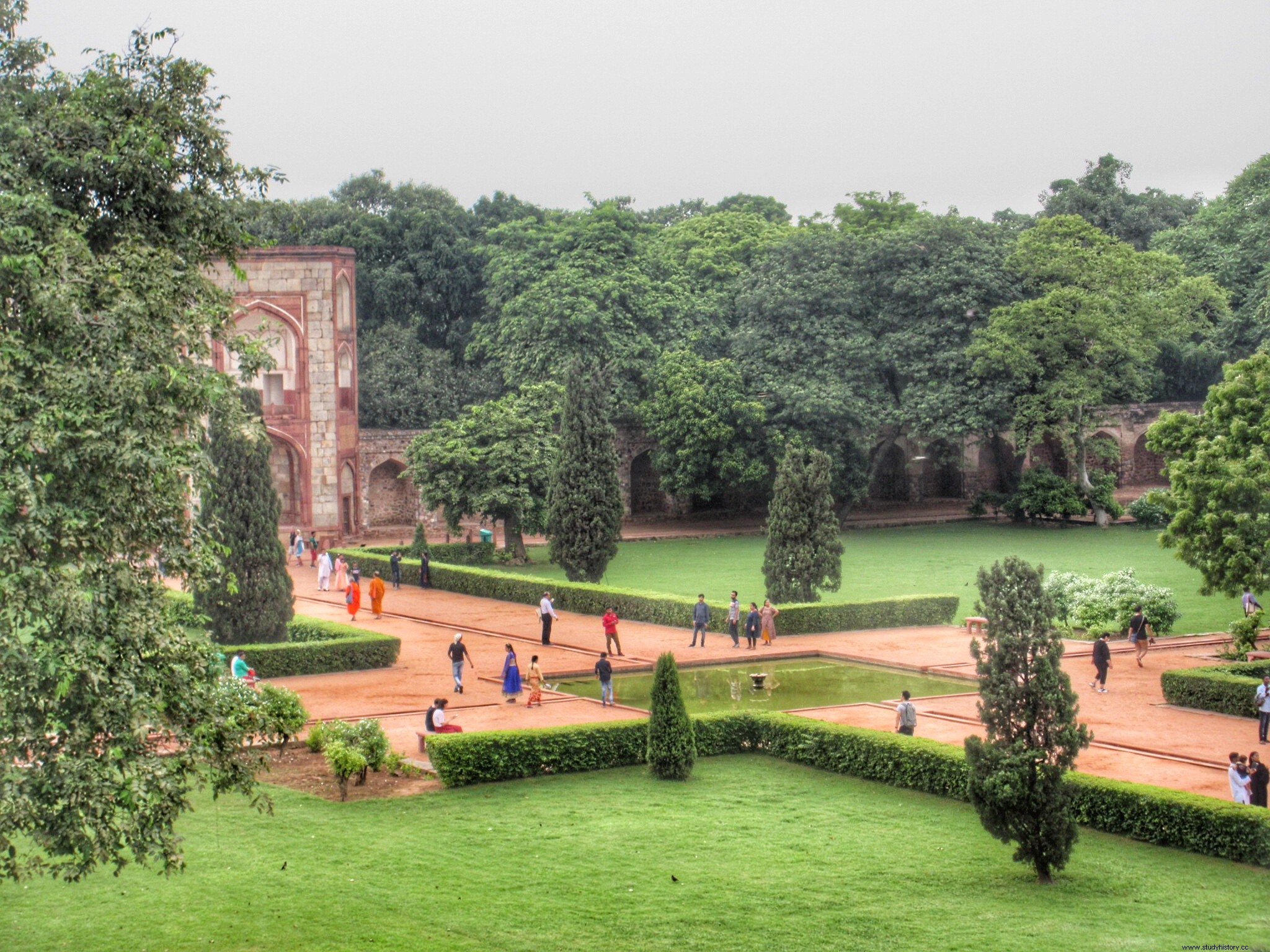
History
This is the tomb of Mughal Emperor Humayun. It is located in Delhi, India. It was commissioned by his first wife, Haji Begum, in the year 1558. It was designed by Persian architects and these architects were chosen by her. This tomb is of red color, which is sandstone. It was designed by Mirak Mirza Ghiyas and his son. Sayyid Muhammad was the son of Mirak Mirza. This was the first tomb to have the Mughal Gardens at that time.
It too was declared a UNESCO World Heritage Site in ancient times. Humayun died on January 27, 1556. After his death, his body was first buried in his palace, Purana Quila. Then Akbar visited the tomb in 1571 when the tomb was about to be completed. Akbar was also the Mughal emperor. Secondly, it was taken to Sir Hind in Punjab.
This tomb was built by Persian architecture on the orders of his first wife in memory of Humayun. The construction of the tomb took 8 years to complete, from 1565 to 1572. The total cost was 1.5 million rupees. The entire payment was made by his first wife, named Bega Begum. After her husband's death, she was so sad and dedicated herself to making a tomb in memory of her husband.
An English merchant named William Finch visited in 1611. He had seen everything inside the tomb and described everything about the tomb. He told us about the rich rugs and other things associated with the tomb. In 1882, the first report was published in India. India was divided in August 1947. At that time, Purana Quila and Humayun's tomb became refugee camps together. These camps were for Muslims. They were administered by the government and originally migrated to Pakistan. The important phase of complex restoration began around 1993. Further, this monument was declared a World Heritage Site.
Humayun Tomb Timings
Humayun's Tomb is open for visits from 8 AM to 6 PM IST. It remains open throughout the week. Visitors can visit and enjoy it at any time of the day.
Travel and vision
The beautiful tomb of Humayun is located in Delhi. It was commissioned by Humayun's first wife and chief consort, Empress Bega Begum, in 1558. It was designed by Mirak Mirza Ghiyas and his son, Sayyid Muhammad, Persian architects.
The best and easiest way to visit this place is if you come via Delhi Metro. If you are from abroad, you need to hire a travel guide. If you are coming via the subway, you must take the subway at Jawahar Lal Nehru Stadium subway station. Get off the subway station and take an E-rikshaw or car from Jawahar Lal Nehru Stadium Subway Station to Humayun's Tomb. It is almost 2 km from the station to Humayun's tomb. Enjoy the drive into Delhi for 2 km and now you are at Humayun's tomb.
You will first find a parking space after entering the gate. Parking facilities are well available there. The most beautiful you will find there are the wonderful paintings on the walls near the ticket window. There are two entrance gates, one for the local country and another for other countries or travelers. There are wonderful facilities for visitors. This place is open on Sunday as well. You can visit here every day. First you have to get a ticket to get in. The entrance fee is 30 rs for Indians and 500 for foreigners. After receiving the ticket, you can enter the grave. Upon arrival you will find a lot of green in the environment that you will find very pleasing to the eyes. The security staff were so polite to the visitors. There is a water tank near the entrance gate from which you can drink fresh and RO-purified water.
You will reach three large gates to reach the entrance to the tomb. After leaving the third gate, you will see a wonderful gate to the tomb. It looks like the historical monument Taj Mahal. In fact, this place is older than the Taj Mahal. It is not surprising that the Taj Mahal was built on the basis of Humayun's tomb design. The only difference is that Humayun's tomb is made of red stone, while the Taj Mahal is made of white stone called Sangmarmar. This beautiful building is fully covered with trees and greenery. There are 30 acres of Mughal garden covering the tomb from all four sides. You can sit there and feel the peace there. You can come with your family and create some beautiful family moments. This Mughal garden looks like a Persian garden. It is said that there were no gardens like this Mughal garden before in India.
Architecture and design
Humayun's tomb was the first Mughal garden in India. It is located in Nizamuddin, east of Delhi. This tomb has various design masterpieces. It consists of Persian architectural traditions and Indian architecture.
After visiting there, you can trace Persian influences. There are some features of the Guri I Amir Mausoleum Samarakhand of the Persian.
Screenshots by Archs
Minorities on both sides
-Dome elevated on drum
- Disposable portal designed by an arch
-Iwan
Guri I Amir Mausoleum consists of two minarets on both sides and forms a building. Then you enter through an entrance portal and in the center you will find a tomb that is elevated to a drum. So here I found a resemblance between the tomb of Timurid and the tomb of Humayun. The Timurid tomb is the West Asian tomb built of brick clad with glazed ceramic tiles, while the Humayun tomb is built of brick with red sandstone and white marble.
Now I trace the Indian inspirations for the design. The design strategy for raising a building can be seen in the Sher Shah Suri tomb at Sasaram and in the tradition of Hindu temples (Lakshmana temple, Khajuraho) and the same strategy can be seen in Humayun's tomb. It is a tomb building that is elevated on a 7 meter high plinth. Humayun's tomb is a combination of red sandstone and white marble. These materials are common in Khan E Khanan's tomb, Delhi.
Building Plan

The tomb is located in the center of a square garden of 348 meters x 348 meters. It is surrounded by 5 meter high walls. These high walls are on 8 sides and punctured by entrance gates. Here we can also find that the paths are in smaller squares. Sikander Lodi's grave is present in the center of the garden. The garden is a typical Persian garden with Char Bagh layout. It is a four-part garden. Colorful vegetation, water canals and water tanks are ideal for the Mughal garden.
Char Bagh and other monuments
Char Bagh, or we can call it "Four Garden" is located in the middle of Humayun's tomb. It is located in the center of a 30 acre area. It is a Persian-style garden that has a square layout. It was the first of its kind in the South Asia region. There are two central water channels that share each other. These reflect the four rivers. The stream of these rivers is Jannat and the Islamic concept of paradise. The whole of Humayun's tomb and Mughal garden are completely enclosed by brick walls on three sides, and the fourth side is for the Yamuna river.
There are several monuments, such as Bu Halima's tomb and garden, Afsarwala tomb and garden, Arab Serai, Nila Gumbad, Chillah Nizamuddin Aulia, Isa Khan Niyazi are also included in Humayun's tomb.
Below are the pictures of these monuments.
Bu Halima's Tomb and Garden

Nila Gumbad ca 1625

Char Bagh

Tomb and Mosque of Isla Khan
When you enter from the western direction of the gate, you will see many monuments on both sides of the path to the gate that goes in the direction of Humayun's main tomb. This tomb also consists of a mosque adjacent to the tomb. It is also made of the same red sandstone used in the main tomb.
Barber's Tomb
Barber's tomb is also present there, and it is surrounded by the four gardens (Char Bagh). Barber's tomb is also known as Nai ka Gumbad. This is the only structure besides the main tomb of Humayun.
Restoration
Humayun's tomb was restored in 1997 after six years of restoration project work. Under Prime Minister Dr. Manmohan Singh, this restoration project was considered the "largest and most ambitious conservation project" in India.
Frequently Asked Questions
Question:What is the time of Humayun's grave?
A:8 am to 6 pm are the opening and closing hours for Humayun's tomb. It is open all week.
Question:Who was Humayun?
A:Humayun was the second Mughal emperor. He also ruled Afghanistan, Pakistan and northern India. He was the son of Babur. His father was the founder of the Mughal dynasty. Humayun became Emperor of the Mughal Empire at the age of 23.
Question:What's the name of Humayun's son?
A:Akbar and Farrukh-Fal Mirza were two sons of Humayun.
Question:Who was Humayun defeated by?
A:Humayun was defeated by Sher Shah Suri. He was the Afghan leader. Sher Shah Suri defeated Humayun in 1540.
Question:Where is Humayun's tomb located?
A:Humayun's tomb is located in Nizamuddin East, Delhi. It's near Purana Quila or the ancient fort.
